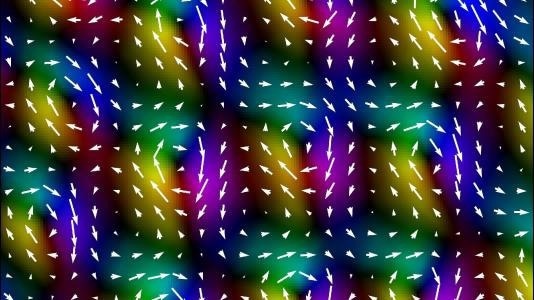Invisible fields tend to produce magnets that attract some materials. A common instance is fridge magnets. Much more important to one’s daily life, magnets also have the potential to store data in computers.
 Magnetic fields created by skyrmions in a two-dimensional sheet of material composed of iron, germanium, and tellurium. Image Credit: Argonne National Laboratory.
Magnetic fields created by skyrmions in a two-dimensional sheet of material composed of iron, germanium, and tellurium. Image Credit: Argonne National Laboratory.
Using the direction of the magnetic field, each microscopic bar magnet can store one bit of memory as a zero or a one, which is the language of computers.
Researchers at the US Department of Energy’s (DOE) Argonne National Laboratory want to substitute the bar magnets with small magnetic vortices. As small as billionths of a meter, such vortices are known as skyrmions, which form in some magnetic materials.
They could someday guide a new generation of microelectronics for memory storage in high-performance computers.
The bar magnets in computer memory are like shoelaces tied with a single knot; it takes almost no energy to undo them. By contrast, skyrmions are like shoelaces tied with a double knot. No matter how hard you pull on a strand, the shoelaces remain tied.
Arthur McCray, Graduate Student, Northwestern University
McCray is currently working in Argonne’s Materials Science Division (MSD).
Bar magnets malfunctioning due to a few interruptions will impact the others. However, skyrmions are known to be quite stable to any interruption. One more significant feature is that researchers have the potential to regulate their behavior by altering the temperature or employing an electric current.
Researchers have much to explore regarding skyrmion behavior under various conditions. To learn them, the Argonne-led group advanced on an artificial intelligence (AI) program that functions with a high-power electron microscope at the Center for Nanoscale Materials (CNM), a DOE Office of Science user facility at Argonne. Also, the microscope could envision skyrmions in samples at very low temperatures.
The magnetic material is a mixture of iron, tellurium, and germanium. In structure, this material is similar to a stack of paper with several sheets. A stack of such sheets comprises several skyrmions, and a single sheet could be stripped from the top and examined at facilities like CNM.
“The CNM electron microscope coupled with a form of AI called machine learning enabled us to visualize skyrmion sheets and their behavior at different temperatures,” stated Yue Li, a postdoctoral appointee in MSD.
Our most intriguing finding was that the skyrmions are arranged in a highly ordered pattern at minus 60 degrees Fahrenheit. But as we cool the sample the skyrmion arrangement changes.
Charudatta Phatak, Materials Scientist and Group Leader, Materials Science Division, Argonne National Laboratory
Similar to bubbles in beer foam, a few skyrmions turn out to be bigger, a few smaller, some unite, and some tend to disappear.
At -270 degrees Fahrenheit, the layer reached a state of nearly complete disorder, but the order returned when the temperature returned to -60 degrees Fahrenheit. This order-disorder shift with temperature change can be used in future microelectronics for memory storage.
We estimate the skyrmion energy efficiency could be 100 to 1000 times better than current memory in the high-performance computers used in research.
Arthur McCray, Graduate Student, Northwestern University
Energy efficiency seems to be necessary for the next generation of microelectronics. At present, microelectronics account for a prominent fraction of the world’s energy use and could use up around 25% within the past few years. Highly energy-saving electronics should be discovered.
Phatak stated, “We have a way to go before skyrmions find their way into any future computer memory with low power. Nonetheless, this kind of radical new way of thinking about microelectronics is key to next-generation devices.”
This study was financially supported by the DOE Office of Basic Energy Sciences. The machine learning program of the team was made to function on supercomputing resources at the Argonne Leadership Computing Facility, a DOE Office of Science user facility.
Besides Phatak, Li, and McCray, Argonne’s authors involve Amanda K. Petford-Long, Daniel P. Phelan, and Xuedan Ma. The other authors include Krishna Pandey, Rabindra Basnet, and Jin Hu from the University of Arkansas.
Journal Reference:
McCray, A. R. C., et al. (2022) Thermal Hysteresis and Ordering Behavior of Magnetic Skyrmion Lattices. Nano Letters. doi.org/10.1021/acs.nanolett.2c02275.